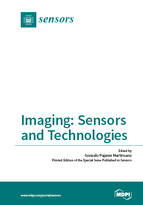Imaging: Sensors and Technologies
A special issue of Sensors (ISSN 1424-8220).
Deadline for manuscript submissions: closed (30 September 2016) | Viewed by 300474
Special Issue Editor
Interests: computer vision; image processing; pattern recognition; 3D image reconstruction, spatio-temporal image change detection and tracking; fusion and registering from imaging sensors; superresolution from low-resolution image sensors
Special Issues, Collections and Topics in MDPI journals
Special Issue Information
Dear Colleagues,
The use of imaging sensors in different areas is obvious. Actively or passively, these sensors capture electromagnetic radiation or acoustic echoes across the whole spectra, which, conveniently arranged in images, allow the extraction of useful information.
Among others, medicine, biology, industry, agriculture, surveillance, security, visual inspection, monitoring, target tracking, photogrammetry, robotics, and navigation aids in manned or unmanned vehicles are areas where advances in imaging sensors and technologies play an important role.
Methods and procedures that are designed to make operational and profitable imaging devices allow for the processing of the relevant information that is oriented toward the efficiency of such systems.
The following is a list of the main topics covered by this Special Issue, where the emphasis is placed on the sensors, devices, and technologies that are oriented toward specific image processing applications. The Special Issue will, however, not be limited to these issues:
• Active or passive sensors and technologies based on physical designs, including CCD, EMCCD, CMOS, NMOS, and Photodiodes.
• Mono-, multi-, and hyper-spectral sensors for spectral analysis: ultraviolet, visible, infrared, thermal, laser or X-Ray.
• Sensors and technologies for radiography, tomography, magnetic resonance, neuroimaging, and microscopy.
• Sensors and technologies for 3D recovery: stereoscopy, TOF, and Laser.
• Multiple and temporal imaging sensors and technologies: video, panoramic,
• Radar and SAR devices.
• Acoustic sensors and devices: ultrasound, sonar.
• Image acquisition and formation: physical and geometric sensory arrangement, optical systems, and spectral filters.
Prof. Dr. Gonzalo Pajares Martinsanz
Guest Editor
Related Journal: Journal of Imaging
Manuscript Submission Information
Manuscripts should be submitted online at www.mdpi.com by registering and logging in to this website. Once you are registered, click here to go to the submission form. Manuscripts can be submitted until the deadline. All submissions that pass pre-check are peer-reviewed. Accepted papers will be published continuously in the journal (as soon as accepted) and will be listed together on the special issue website. Research articles, review articles as well as short communications are invited. For planned papers, a title and short abstract (about 100 words) can be sent to the Editorial Office for announcement on this website.
Submitted manuscripts should not have been published previously, nor be under consideration for publication elsewhere (except conference proceedings papers). All manuscripts are thoroughly refereed through a single-blind peer-review process. A guide for authors and other relevant information for submission of manuscripts is available on the Instructions for Authors page. Sensors is an international peer-reviewed open access semimonthly journal published by MDPI.
Please visit the Instructions for Authors page before submitting a manuscript. The Article Processing Charge (APC) for publication in this open access journal is 2600 CHF (Swiss Francs). Submitted papers should be well formatted and use good English. Authors may use MDPI's English editing service prior to publication or during author revisions.







